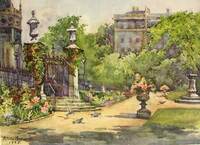While the Benchers' Garden was being made, the Great Garden was not neglected. Its form was altered to suit the prevailing taste. This remodelling must have begun in the winter of 1703, as it was then resolved that "the trees in the Great Garden be cut down, and the Garden to be put in the same model as the gardener hath proposed." The delightful terrace, which is still one of the most beautiful features in the Garden, existed before these alterations began, but the sun-dial which still adorns it was added during these changes. The payment for it was made to Strong, who was contractor for St. Paul's under Wren: "To Edward Strong, for the pedestal for the dial in the Great Garden steps, &c., �25." The beautiful gates of wrought iron were put up in 1730. The design shows the arms of Gray's Inn, as well as the winged horse of the Inner Temple, in compliment to the other learned society, its close ally. In the same way the Pegasus occurs at Gray's Inn. It was probably along this terrace that some of the orange trees in pots were placed during the summer. The pots in which these oranges and other "greens" were grown seem to have been specially decorative. It was a serious offence when Allgood, a member of the Inn, broke some, and was obliged to "furnish other pots of like fashion and value," otherwise he would "be put out of commons." After this others were purchased, as the payment of �8 was made "for a large mould, carved in wood, for casting of earthen pots for the Garden"; and in other years further similar expenses occur, one in 1690 "to the potter for a large pot made for the Garden, painted in oil, �1, 5s." Some of the plants grown would stand the winter in the open, but after the oranges made their appearance a shelter had to be provided. Green-houses owed their origin to this necessity, and as they were only used in winter, and merely sheltered the large pots of "greens," these green-houses or orangeries were built like rooms, and used as summer-houses during warm months. All the larger gardens had their green-houses, but the smaller proprietors frequently sent their plants away to a nurseryman to be housed during the winter. Even the "greens" at Kensington Palace were kept by London and Wise, until the new orangery was built. The Temple orange trees were first sent to the house of Cadrow at Islington. In 1704 the green-house seems to have been made, and used as a garden-house in summer. Such items in the accounts as "a chimney-glass and sconces for the green-house" show that it was in the usual solid architectural style then in fashion. That the "panierman," an officer, one of whose duties was to summon members to meals by blowing a horn, was appointed to take charge of it as well as of the library, is a further proof that it bore the character of a room, and was more or less outside the gardener's department. The panierman also had the care of the elaborate fountain, after it had been supervised for some years by the maker. This green-house stood at the end of the terrace, which still runs parallel with Crown Office Row, and near the site of Harcourt Buildings, behind the gardener's house. This gardener's house was pulled down two or three years later to make way for Harcourt Buildings, which was joined to the summer-house. The first or ground floor opened on to the garden below the "paved walk" or terrace, on which level stood the summer-house.

